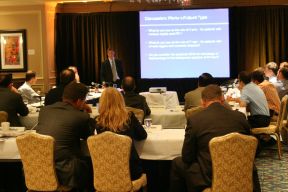 At the heart of your advisory board, you should find engaging, and even impassioned, discussions by Key Opinion Leaders (KOLs). They want to help you make a difference. Planning for effective communication within your advisory board will allow for a higher impact advisory board so you can glean more insights from your advisors. When preparing, there are several important practices that can lead to better dialogue between your advisors.
At the heart of your advisory board, you should find engaging, and even impassioned, discussions by Key Opinion Leaders (KOLs). They want to help you make a difference. Planning for effective communication within your advisory board will allow for a higher impact advisory board so you can glean more insights from your advisors. When preparing, there are several important practices that can lead to better dialogue between your advisors.
Communicate with your Faculty
Once your faculty have been confirmed and the working agenda has been laid out, the content development process begins. Set up conference calls or web conferences with your faculty. Web conferences where you can see one another and see the content at the same time are optimal. They allow for a more effective use of time and create a more dynamic meeting that can further relationship building.
On your faculty calls, discuss your objectives and ask for recommendations as to how you can achieve your goals. While you must remain within the boundaries of the compliance framework that governs your business, give them some freedom to be creative. Ask them to communicate as if they were telling a story and, assuming it is accurate and meets your regulatory guidance, let them.
Keep Dialogue Open
Effective sessions allow for about 50% of the time for a formal presentation and at least 50% of the time for reactions and input by the attendees. Your chairperson will guide the discussion section with your information-gathering objectives in mind.
Each of these conference calls/web conferences are continued opportunities to build relationships with your advisors. Seize these opportunities and truly get to know them as individuals each chance you get. Once your agency has properly compiled the agenda, finished working with the faculty on the presentations, and fully prepped the faculty, you and your agency can finalize the on-site logistics.
Be Prepared
Prior to the meeting, schedule on-site time with the faculty by hosting a slide-rehearsal session. Ensure that your chair is present and allow time for everyone to review his or her slides. Use this as one last opportunity to finalize content, double-check that all objectives have been covered and confirm that your chair knows what to expect from each presentation. This ensures that the chair is fully informed about the discussion and understands the timing of each talk.
Set the Table
The room should be set in a U-shape to put all attendees on par with one another. This environment is conducive to conversation, as everyone can engage with one another. A few company representatives should sit at the “U” to actively participate, but be cautious not to overexpose the company and make the advisors feel overwhelmed and unwilling to be as forthcoming as possible.
Spending ample time planning your content with the faculty, encouraging participation with the right room layout, and fostering open discussions with plenty of time for feedback are keys to delivering excellent content. Seize every opportunity to get to know your participants; this will make them much more receptive to the information you want to communicate and much more willing to give you honest, valuable feedback.





